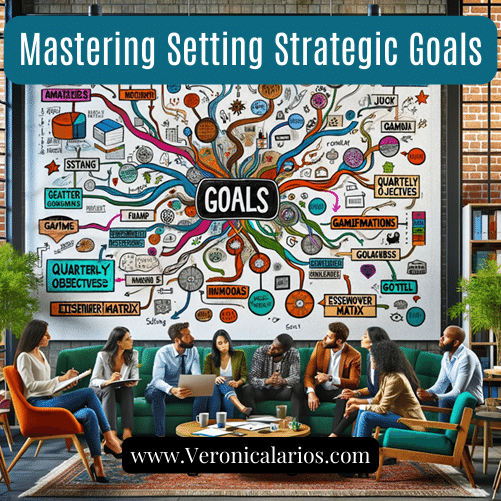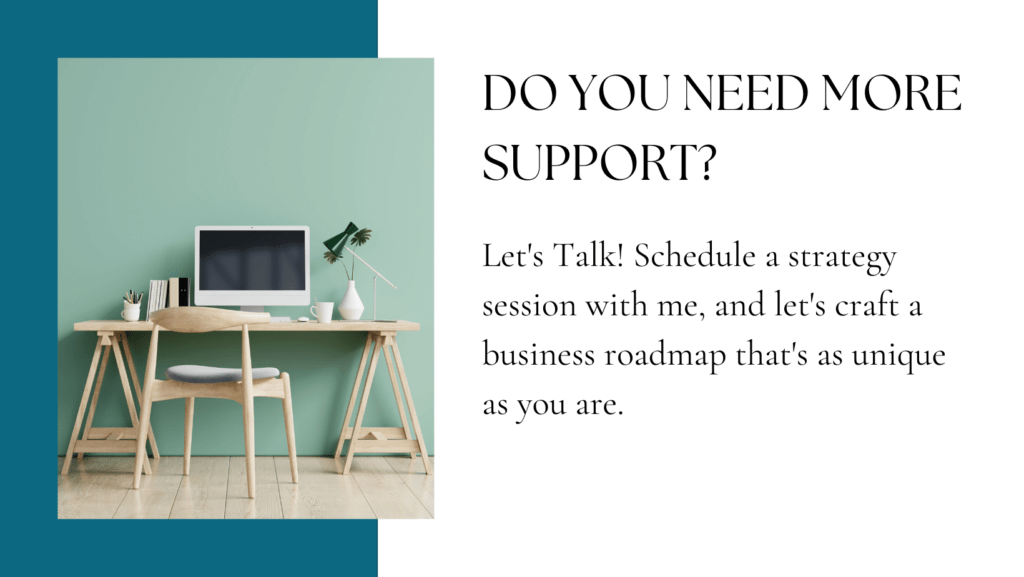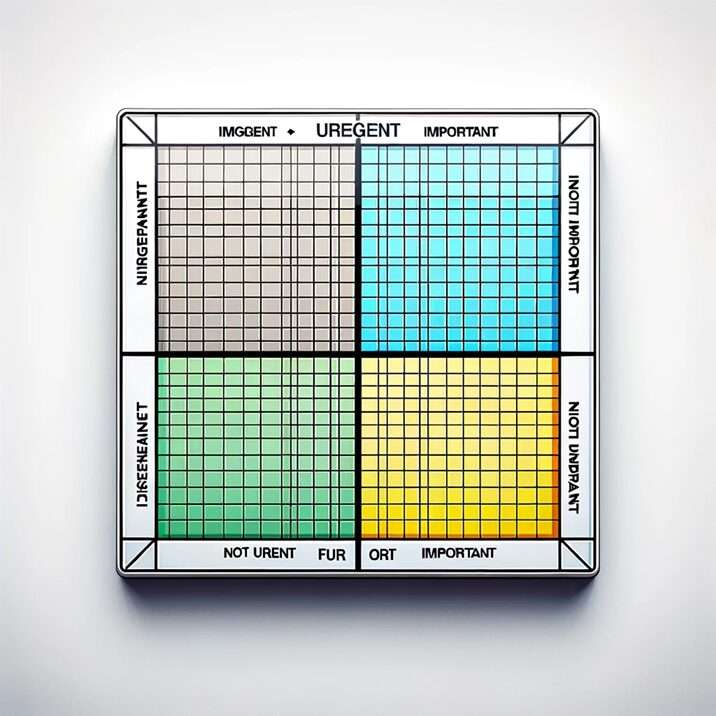
Ever wondered why setting strategic goals often feels overwhelming?
I know, I know – some of you might be rolling your eyes at the thought of long-term planning or New Year’s resolutions we all heard about. Let’s face it, not everyone is cut out for traditional business planning. And that’s okay! The key is to find a strategy that aligns with your style, one that doesn’t feel like a chore. Why is it important? Because did you know that entrepreneurs who set strategic goals are 30% more likely to succeed?
Maybe you’re the type who finds SMART goals a bit yawn-inducing, or perhaps the whole idea of detailed planning just isn’t your jam. But stick with me, because I’m about to show you how breaking down your aspirations into bite-sized, manageable pieces can actually be quite fun and incredibly effective. But before we dive into methods, let’s understand why a roadmap is essential in this journey.
Why a Roadmap Matters (Even If You Hate Maps)
First things first, let’s talk about why having some sort of plan is crucial for strategic goal setting. Imagine setting off on a road trip with no idea of your destination. Sure, the journey could be exciting, but you might end up going in circles or, worse, stuck in the middle of nowhere. Business is similar – without a roadmap, you’re essentially moving without direction.
Research has consistently shown that setting goals leads to higher performance. In a study conducted by the Dominican University in California, it was found that those who wrote down their goals accomplished significantly more than those who did not. But how do we make this process less daunting and more tailored to our style?
The Simplicity Secret: Smaller Steps to Achieve Big Goals
Here’s where we bring in the concept of breaking down our big, scary goals into smaller, less intimidating ones. Think of it like eating a pizza – you don’t just shove the whole thing in your mouth; you take it slice by slice. Similarly, setting quarterly objectives or even weekly micro-goals can help you stay on track without feeling overwhelmed.
For instance, the 12 Week Year, a book and concept popularized by Brian Moran, suggests that instead of annual planning, we break down our year into 12-week periods. Each period is treated as a ‘year,’ with its own set of achievable goals. This approach not only makes your goals seem more immediate but also provides frequent opportunities for assessment and adjustment. Now, let’s explore some strategies that can help make this process easier and more enjoyable.
Step-by-Step Guide to Setting Attainable Goals
- Reflect and Identify: Start by reflecting on what you genuinely want to achieve. It could be increasing sales, expanding your network, or even learning a new skill. The key is honesty with yourself on what’s important to you.
- Break It Down: Once you have your main objective, break it down further. For example, if your aim is to increase sales by 20% annually, set a 5% increase as your quarterly target. Studies have shown that making it easier to follow smaller tasks makes it easier to achieve.
- Make It Actionable: This is where you choose the strategy making it actionable.
Here are a few approaches that might appeal to you:
Getting Things Done (GTD) – David Allen’s GTD methodology focuses on freeing up mental space by getting tasks out of your head and into a trusted system. This method is great for those who feel overwhelmed by their to-do list.
Gamification of Objectives: Who said goal setting can’t be fun? Turn your objectives into a game. Create milestones of and set up rewards for each milestone you achieve. This approach keeps motivation high and can transform mundane tasks into exciting challenges.
The Eisenhower Matrix: Prioritize your tasks based on urgency and importance using the Eisenhower Matrix. It helps in decision-making and ensures you’re focusing on what truly matters, reducing the overwhelm of having too much on your plate.
Agile Principles: Borrowing from the world of software development, Agile methodology can revolutionize how you approach your business goals. Agile focuses on adaptability. Create tasks that have key points where you can make any adjustments and changes- making it ideal if you want to be flexible.
Mind Mapping: Brainstorm and organize your thoughts in a visual and creative way! This method is great when you have no idea where to start, plus it is a throwback to the cluster maps we’d do back in grammar school. Start with your main goal in the center and branch out with related ideas, strategies, and tasks.
The beauty of these methodologies is they offer flexibility. They cater to different personalities and styles, from the visual thinker who thrives on mind mapping to the game enthusiast who finds motivation in gamification.
Personalizing Your Goal-Setting Approach
One of the most critical aspects of successful goal planning is personalization. Every individual and business operates differently, which means a one-size-fits-all approach to goal setting rarely works. Why limit yourself to just one method when a combination might suit you better? For instance, you might find that the structure of the Eisenhower Matrix helps in prioritizing tasks, while the fun element of Gamification keeps you engaged. Or perhaps, the flexibility of Agile Principles works best for your dynamic business environment, complemented by the creative brainstorming that Mind Mapping offers.
Using more than one method allows you to tailor your goal-setting process to your unique needs and preferences. It enables you to take advantage of the strengths of different methodologies while mitigating their limitations. This personalized approach not only increases the likelihood of achieving your goals but also makes the journey more enjoyable and aligned with your way of working. Remember, the key to effective goal setting is finding a strategy (or a mix of strategies) that resonates with you and your business ethos.
Remember, strategic goal setting is not a one-size-fits-all process. It’s about finding what resonates with you and your business ethos. Different methods work for different people, as you’ll see in the following real-world example.
Real-World Impact: An example of a client’s Journey in Goal Setting
Alex felt overwhelmed with the idea of setting long-term goals for his business. After exploring various goal-setting methodologies, he discovered a mix that worked for him: a combination of the Eisenhower Matrix for prioritizing tasks and Gamification for keeping the process engaging.
Alex started by identifying his primary goal: to increase local community engagement for his art business. Using the Eisenhower Matrix, he prioritized tasks that were both important and urgent, like hosting monthly local gallery events. For the gamification aspect, he set up a reward system for himself. Each successfully organized event earned him a small personal reward for one of his hobbies.
This story illustrates the power of finding a goal-setting strategy that aligns with individual preferences and business needs, showcasing how personalization in approach can lead to enjoyable and successful outcomes.
Track Your Progress
Tracking your progress is crucial in strategic goal setting. It not only gives you a clear picture of where you are but also boosts your motivation as you see tangible evidence of your efforts. Here are some effective ways to keep track:
- Journaling: Maintain a daily or weekly journal. This can be a simple notebook where you jot down your accomplishments and reflections. The act of writing can be a powerful tool for self-awareness and keeping track of your progress.
- Digital Trackers: Utilize apps like Trello or Asana for digital tracking. These tools allow you to set tasks, deadlines, and even share your progress with others. They are especially useful for visualizing your progress and managing multiple aspects of your goals.
- Regular Check-Ins with a Coach or Mentor: Hiring a coach or finding a mentor can provide professional guidance and an external perspective. They can help you stay on track, challenge your thinking, and offer advice based on their experience.
- Accountability Partners: Pair up with a friend or colleague. Schedule regular check-ins, maybe weekly or monthly, to discuss your goals and progress. For instance, I have an accountability partner from a business group I’m part of. Despite being in different time zones, we connect regularly to keep each other on track.
Example App for Tracking: Consider using an app like ‘Goal Tracker & Habit List,’ which allows you to set goals, track your progress, and set reminders for your daily tasks. This can be particularly helpful in maintaining consistency and keeping your goals top of mind. While tracking progress is key, it’s also important to understand the role of habits in achieving goals.
Beyond Motivation: The Power of Micro Habits
Remember, relying solely on motivation to reach your strategic goals can be a slippery slope. Motivation is an emotion that ebbs and flows; it’s not always going to be there when you need it. This is where the true power of micro habits comes in.
Micro habits are small, manageable actions that you can incorporate into your daily routine. They are so simple that they require minimal motivation to complete. For example, if your goal is to improve your networking skills, a micro habit might be to reach out to one new contact each day. These habits might seem insignificant on their own, but over time, they accumulate and lead to significant progress.
The beauty of micro habits is that they start to build momentum. As these small actions become a part of your daily life, they lay the groundwork for consistency& creating the habit. By focusing on these tiny, routine actions, you’re not as reliant on bursts of motivation; instead, you’re building a sustainable path to success.
Review and Adjust
The beauty of setting strategic goals is with turning them into micro-goals – and having flexibility adjusting your path. Here’s how you can effectively review and adjust your strategies:
- Weekly or Monthly Reviews: At the end of each week or month, take time to review what you’ve achieved. Look at what tasks were completed, what challenges you faced, and what lessons you learned.
- Pivoting Strategy: If a particular approach isn’t working, don’t hesitate to pivot. Because these are micro-tasks, changing your strategy usually doesn’t have a huge impact on your overall plan. It’s about finding what works best for you.
- Staying Flexible: Flexibility is key. The goal-setting process is personal and dynamic. What works for one might not work for another. Be open to experimenting with different methods, schedules, and tools until you find what fits your personal and professional rhythm.
- Learning from Setbacks: Embrace any setbacks as learning opportunities. Each challenge is a chance to refine your approach and learn more about what drives your success.
By incorporating these strategies into your goal-setting process, you can ensure that you stay on track to achieving your aspirations. With these strategies in mind, let’s wrap up with the key takeaway of our approach to strategic goal setting.
The Takeaway on strategic goal setting
By breaking down your goals into smaller, manageable tasks, you make the process less intimidating and more achievable. We don’t have to start with many goals either. Just have one main goal you can think of, fantastic- just focus on that.
Here’s a little nudge for those who might need an extra hand!


